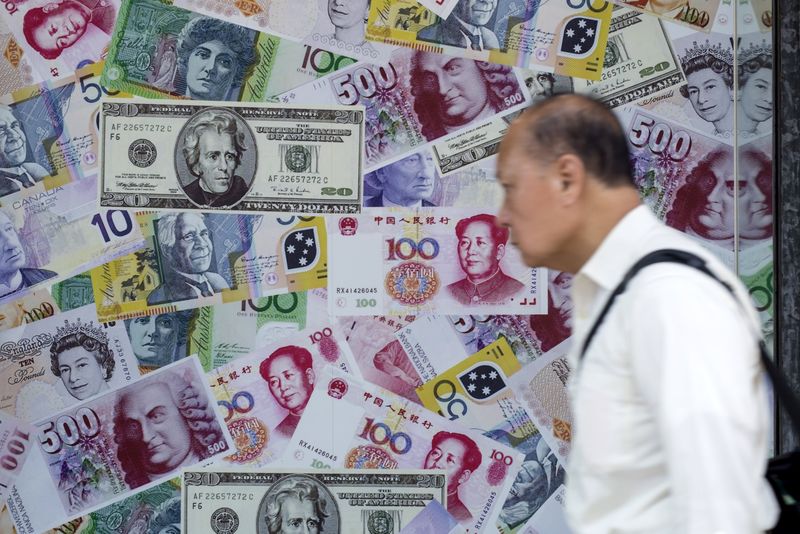* China retail sales, industrial production in focus
* Thai baht leads weekly gains
* Singapore dlr worst weekly performer, set to drop 0.4%
(Adds text, updates prices)
By Ambar Warrick
June 14 (Reuters) - Asian currencies edged slightly lower on
Friday, with most units set to lose after a week marked by
continued pessimism over a U.S-China trade deal.
Chinese retail sales and industrial output data for May due
out later in the day will give investors some idea of how well
demand was holding up in the world's second-largest economy,
following a substantially weaker reading for April.
A U.S. Federal Reserve meeting next week also saw markets
adopting a wait-and-see approach, with weaker economic data seen
over the past few days pushing the case lower interest rates,
with most bets on a cut in July. U.S. retail sales data later in
the day is also expected to be a point of focus.
"Markets will have to continue to triangulate between the
FOMC, global trade tensions, and a global macro deceleration,"
OCBC's Emmanuel Ng said in a note.
He also said that "investors may remain on edge", and that
a pivot to safe havens such as the Japanese yen and Swiss franc
seemed likely if risk aversion "flares up again."
The Singapore dollar SGD= weakened 0.1% to the dollar, and
was set to be the biggest weekly loser amongst its peers.
Singapore's strong trade relationship with China has made the
island-state especially sensitive to headwinds from the trade
war front.
The currencies of oil importers such as the Indian rupee
INR=IN , Indonesian rupiah IDR=ID and the Philippine peso
PHP= also dipped after attacks on two oil tankers in the Gulf
of Oman sent oil prices up sharply. O/R
The rupiah was the biggest intraday loser, dropping about
0.2% owing to the archipelago's large dependence on crude
imports.
The peso was among the few currencies set to gain this week,
albeit marginally. A public holiday during the week had likely
prompted some local demand for the currency.
The South Korean won KRW=KFTC and the Taiwan dollar
TWD=TP traded in a flat-to-low range, but were set to lose
about 0.2% and 0.3% for the week, respectively, due to a further
deterioration in the global technology sector.
RISK-OFF BENEFITS THAI BAHT
The Thai baht THB=TH led meagre gains in the region,
strengthening about 0.06% to the dollar. It was also the best
weekly performer, with Thai risk assets seeing strong foreign
inflows thanks to relative stability in the country, in
comparison to its emerging market peers.
The currency, which is set for its third straight week of
gains, had outperformed emerging Asia in 2018, and has continued
the trend in so far 2019.
The baht is also among the few Asian currencies to have
bullish positions, as found by a Reuters poll last week.
ASIA/FXP
The following table shows rates for Asian currencies against
the dollar on Friday.
CURRENCIES VS U.S. DOLLAR
Change on the day at 0437 GMT
Currency Latest bid Previous day Pct Move
Japan yen 108.310 108.37 +0.06
Sing dlr 1.367 1.3666 -0.06
Taiwan dlr 31.509 31.512 +0.01
Korean won 1184.200 1183.1 -0.09
Baht 31.210 31.23 +0.06
Peso 51.880 51.85 -0.06
Rupiah 14304.000 14275 -0.20
Rupee 69.543 69.51 -0.05
Ringgit 4.167 4.165 -0.05
Yuan 6.924 6.9212 -0.04
Change so far in 2019
Currency Latest bid End 2018 Pct Move
Japan yen 108.310 109.56 +1.15
Sing dlr 1.367 1.3627 -0.34
Taiwan dlr 31.509 30.733 -2.46
Korean won 1184.200 1115.70 -5.78
Baht 31.210 32.55 +4.29
Peso 51.880 52.47 +1.14
Rupiah 14304.000 14375 +0.50
Rupee 69.543 69.77 +0.33
Ringgit 4.167 4.1300 -0.89
Yuan 6.924 6.8730 -0.74
